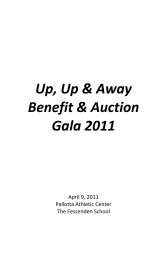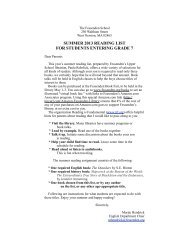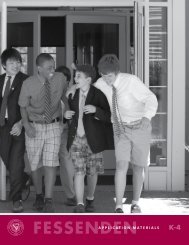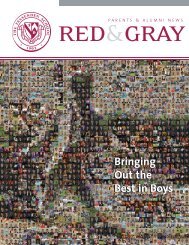Red & Gray Magazine: Focus on Service Learning - The Fessenden ...
Red & Gray Magazine: Focus on Service Learning - The Fessenden ...
Red & Gray Magazine: Focus on Service Learning - The Fessenden ...
- No tags were found...
You also want an ePaper? Increase the reach of your titles
YUMPU automatically turns print PDFs into web optimized ePapers that Google loves.
Upper School students Raphael Chung, ninth grade,and Bobby Min, eighth grade, elected to volunteertheir time during Mudweek for collecting and deliveringfood as well as organizing the shelves at theNewt<strong>on</strong> Food Pantry. While <strong>on</strong> site, boys also had theopportunity to speak with a volunteer who reiteratedthe importance of receiving food d<strong>on</strong>ati<strong>on</strong>s and theimpact their work has <strong>on</strong> local families.Generati<strong>on</strong> Y Serves<strong>The</strong> members of Generati<strong>on</strong> Y also known asthe “Millennials,” have emerged as the mosttolerant generati<strong>on</strong> in history, embracing othersregardless of race, religi<strong>on</strong>, gender, sexual orientati<strong>on</strong>,or cultural difference. Many attributethis open-minded nature to their unparalleledcommitment to community service and socialjustice. As the 78 milli<strong>on</strong> young people in thisgenerati<strong>on</strong>, born between 1981 and 2000, comeof age, they have been groomed by servicelearningopportunities offered by their schoolsand colleges, and they c<strong>on</strong>tinue to demand tospend their time meaningfully, whether at workor at play. M<strong>on</strong>ey is not always the ultimatemotivating factor in the job search forMillennials. <strong>The</strong>y would rather hold out forinteresting work and valuable benefits such asvolunteer service incentives. <strong>The</strong>se young peoplewant to make a difference with their time,and the nati<strong>on</strong> benefits—their commitment totheir communities has been worth more than$34 billi<strong>on</strong> annually to the U.S. ec<strong>on</strong>omy. In fact,UCLA’s Higher Educati<strong>on</strong> Research Institutereported that 66.7% (the highest percentage in26 years) of college students who entered in2006 and will graduate this spring “believed itto be very important to help others.”develop social c<strong>on</strong>fidence and skills. Public students are too young to engage in servicelearning.<strong>Fessenden</strong>’s culture of service beginsschool principals surveyed cited that theirschools participate in service-learning because in Kindergarten with less<strong>on</strong>s that introduceit “helps augment students’ civic behaviors.” boys to the c<strong>on</strong>cept of assisting others in need.Only 12% of them reported valuing participati<strong>on</strong>in service-learning as a means to improve the “All About Me” unit and then transiti<strong>on</strong> to<strong>The</strong> boys are first taught about themselves instudent achievement in core subjects. C<strong>on</strong>verselyat <strong>Fessenden</strong>, we believe a key benefit Guest speakers, such as EMTs, doctors andlearn about the community in which they live.of participati<strong>on</strong> in service-learning opportunitiesis improved student academic achievement community. Together, boys and their teacherspolice officers talk about their positi<strong>on</strong>s in theand self c<strong>on</strong>fidence. Upper School Head Cindy read and discuss books about the differentMetsch articulates: “Any activity which shows community members and their impact <strong>on</strong>that a student is in charge of his acti<strong>on</strong>s reinforcesthat he is also in charge of his academ-youngest students for future participati<strong>on</strong> inothers. <strong>The</strong>se less<strong>on</strong>s prime <strong>Fessenden</strong>’sics. He can see that an afterno<strong>on</strong>’s work at a service activities.soup kitchen or cleaning the envir<strong>on</strong>ment makesSo, why is service-learning such an attractivea difference. <strong>The</strong> student is doing his work forcomp<strong>on</strong>ent of an all-boys educati<strong>on</strong>? Whilehimself, not the teacher or his parents.”each child has a unique cognitive fingerprint,By visiting independent schools’ websites and boys in general desire more c<strong>on</strong>crete learningreading about many of their robust service programs,we can infer that independent schools, in relevance of their work. Utilizing service-learn-opportunities where they can experience thegeneral, have discovered that service-learning ing as a tool to deliver these authentic experiencesand to supplement classroom work inencourages greater student motivati<strong>on</strong> andengagement in and out of the classroom. core subjects is key to realizing its full benefits<strong>Service</strong>-learning benefits the student, the school in an all-boys school. <strong>Fessenden</strong> faculty are asand the community simultaneously. And now, dedicated to teaching social and emoti<strong>on</strong>alpublic schools around the country have been growth as they are to helping boys developincorporating more service opportunities for studentsinto their curricula as well. “Community Scott Smith attests: “Every day <strong>Fessenden</strong> boysintellectual knowledge. Assistant Headmaster<strong>Service</strong> and <strong>Service</strong>-<strong>Learning</strong> in America’s witness some act of generosity toward them thatSchools,” shows that the presence of community goes bey<strong>on</strong>d a faculty or staff member’s jobservice in K-12 schools has risen since 1988. descripti<strong>on</strong>—that is what sets the t<strong>on</strong>e here.Despite this increase in community service programs,however, public elementary schools are boys and their teachers, coaches, dormparentsThrough the relati<strong>on</strong>ships that develop betweenthe least likely to offer service-learning activities or advisors, Fessy boys benefit from the naturewhen compared with public middle and public of giving that our faculty and staff possess.” Athigh schools. Only 20% of the elementary <strong>Fessenden</strong>, we have discovered and c<strong>on</strong>firmedschools surveyed had service-learningthat service-learning activities foster boys’programs. Surprisingly, more than half (51%) further engagement in the learning process.of public elementary school “principals believe Headmaster Peter Drake shares, “<strong>Service</strong>-learningprograms provide boys with the pride ofthat their students are too young to engage inservice-learning.”experiencing their accomplishments first-hand“HE HAS NOT RECEIVED AN AWARD OTHER THAN THE REWARD OFKNOWING HE HAS MADE A DIFFERENCE IN SOMEONE ELSE’S DAY.”– Mary Snow, mother of John ’09, currently enrolled at St. George’s School and Brigham Snow ’11... the tangible results of seeing smiles <strong>on</strong> the<strong>Fessenden</strong>’s philosophy and history of servicefaces of the people helped by their work or thechallenges the idea that elementary schooldramatic change to the landscape at a local6 w w w . f e s s e n d e n . o r g














